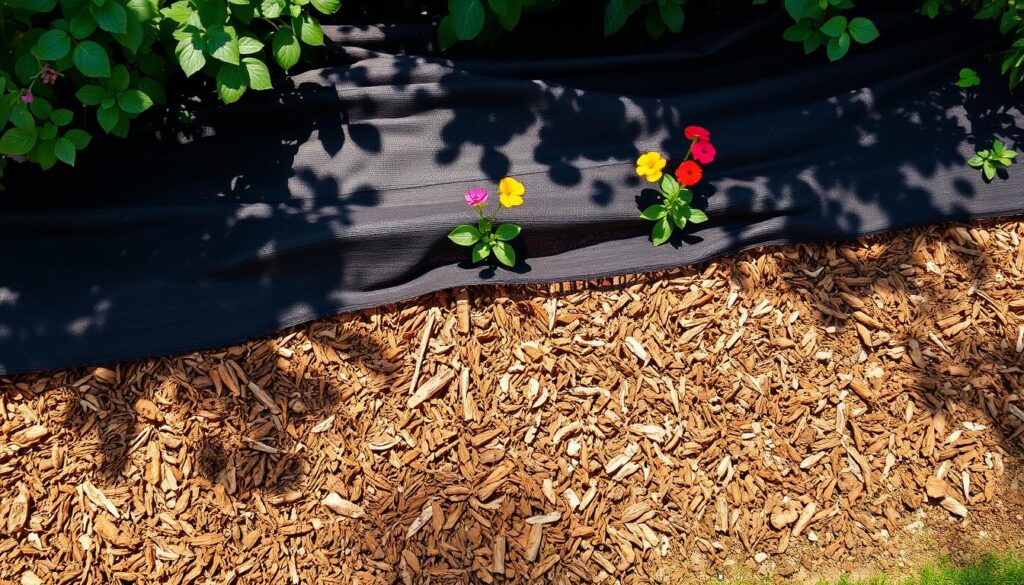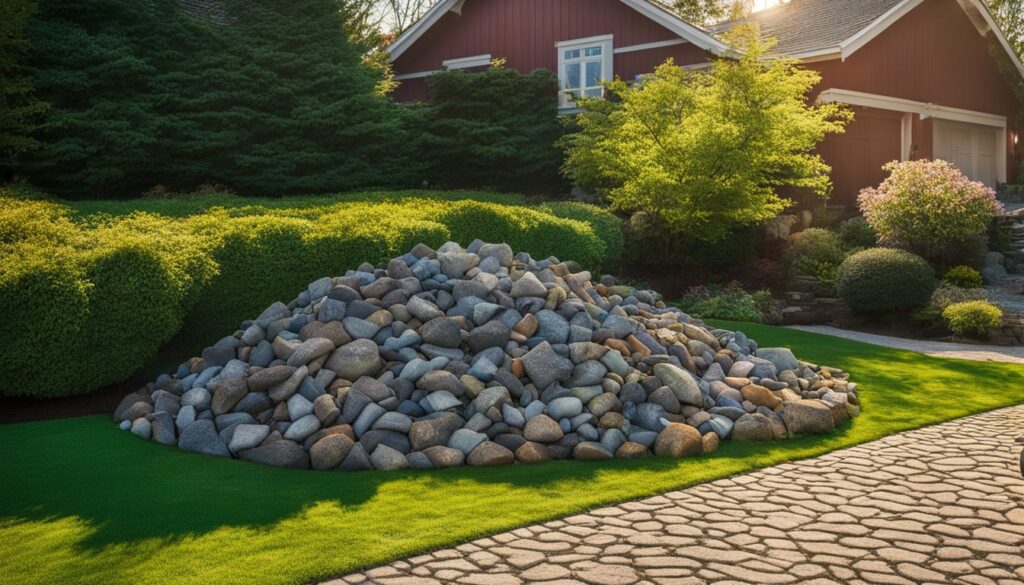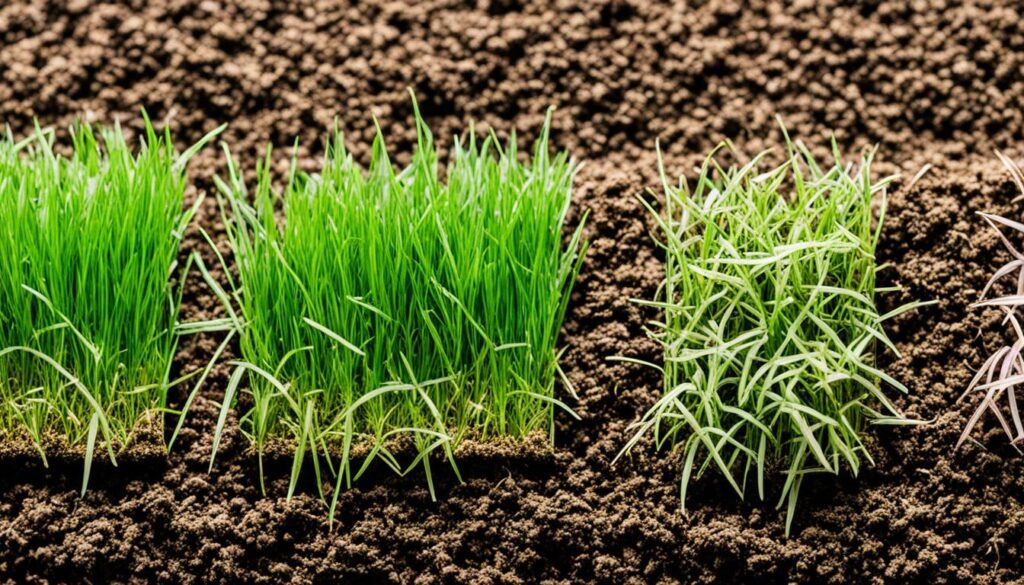Did you know that too much soil around tree roots can suffocate them? Studies show that 8 to 12 inches of soil often covers root flares, harming tree health. This fact highlights the importance of proper garden care, especially with landscaping fabric and mulch. Many people use landscaping fabric to keep weeds away, hoping for a weed-free garden. But, how well these methods work together is key. Let’s explore how landscaping fabric and mulch affect your garden’s health.
Key Takeaways
- Some people use landscaping fabric under mulch for weed control, but its effectiveness can be questionable.
- Mulch plays a vital role in maintaining soil moisture and regulating temperature.
- It’s essential to understand both landscaping fabric and mulch to optimize their benefits for your garden.
- Properly managing these materials can prevent long-term health issues for plants.
- Combining landscaping fabric and mulch improperly may hinder water drainage and root growth.
Understanding Landscaping Fabric
In my gardening journey, I’ve found many types of landscaping fabric. They are key to keeping a garden healthy. Landscape fabric acts as a weed barrier, stopping unwanted plants from taking over. It comes in woven and nonwoven types, with the latter often made of plastic fibers.
These fabrics stop weeds from growing and block sunlight to the soil. This prevents seeds from germinating. But, over time, the fabric can get clogged with soil and organic matter. This can block water and air to the plants, harming their health and growth.
Experts say using mulch can help control weeds without fabric. In places like Tucson, finding the right garden solutions is important. Look for options that work well in your climate and add beauty and function to your garden. For more tips on desert garden decoration, check out this helpful resource.
The Purpose of Mulch in Landscaping
Mulch is key in landscaping for many reasons. It stops weeds from growing, which helps plants get the nutrients and water they need. Mulch covers the soil, making it hard for weeds to take root.
Mulch also keeps the soil moist. This means you water your plants less often. This is great during dry times when keeping the soil healthy is important.
Mulch helps control the soil’s temperature. It keeps the soil cool in summer and warm in winter. This is good for plant growth and health.
As mulch breaks down, it adds organic matter to the soil. This makes the soil better for plants. Using things like leaves, wood chips, and grass clippings as mulch helps the soil. Keeping about 50mm of mulch is best for these benefits.
It’s important to replace mulch as it gets old. You should add new organic mulch every 6 months to a year. This keeps the soil and plants healthy. Mixing different mulches can help with specific soil types, like clay, by keeping moisture in and nutrients available.

| Mulch Type | Benefits | Replacement Frequency |
|---|---|---|
| Organic Mulch | Suppresses weeds, retains moisture, improves soil health | Every 6 months to 1 year |
| Inorganic Mulch | Long-lasting, creates a warm habitat for soil microorganisms | Every few years |
| Wood Chips | Nutrient-rich, excellent moisture retention and temperature regulation | Every 6 months to 1 year |
Forest-like Benefits of Mulch
Creating a garden that feels like a forest has many perks. Organic mulch is key to this change. It breaks down and adds nutrients to the soil, making it richer.
This process also helps beneficial microorganisms grow. It’s like having a mini-ecosystem in your garden.
Recycling mulch is good for the soil and the planet. By using materials like wood chips or shredded leaves, I help the environment. This practice keeps nutrients in the soil and helps it hold water better, just like in forests.
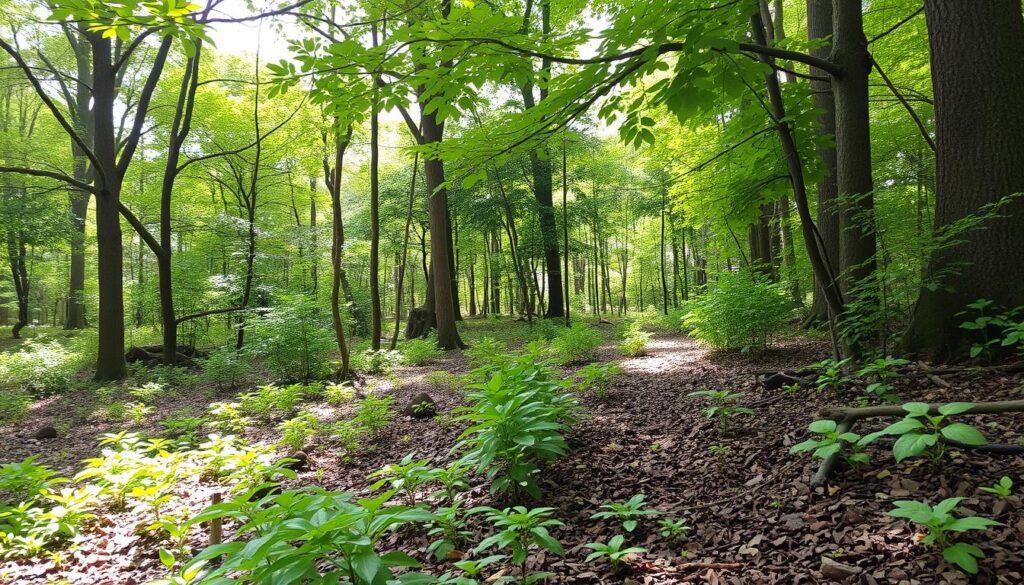
Mulch also helps animals by giving them a place to live and food. I’ve seen more birds and insects in my garden. This balance is good for the garden’s health.
As mulch breaks down, it makes the soil better for plants. This makes my garden more productive. Using mulch helps me keep my garden healthy and balanced, just like a forest.
Reasons to Avoid Using Fabric Under Mulch
In my gardening journey, I’ve found several downsides of landscaping fabric that outweigh its benefits. At first, it seems like a good way to stop weeds. But, it’s not a perfect solution. Seeds from nearby can still grow in the mulch, causing ongoing garden maintenance issues.
Dealing with weeds is hard over time. The fabric gets filled with soil and debris, making it tough to control weeds. This leads to more mulch problems, as weeds can show up, making the garden look messy.
Also, the fabric makes it hard to change my garden’s layout. If I want to move plants or add new ones, the fabric gets in the way. It stops me from having a garden that changes and shows my style.
Many gardeners prefer organic ways to care for their gardens. I use organic pest control solutions to avoid the problems with synthetic barriers. By using natural methods and encouraging different plants, my garden grows well without the issues of fabric under mulch.
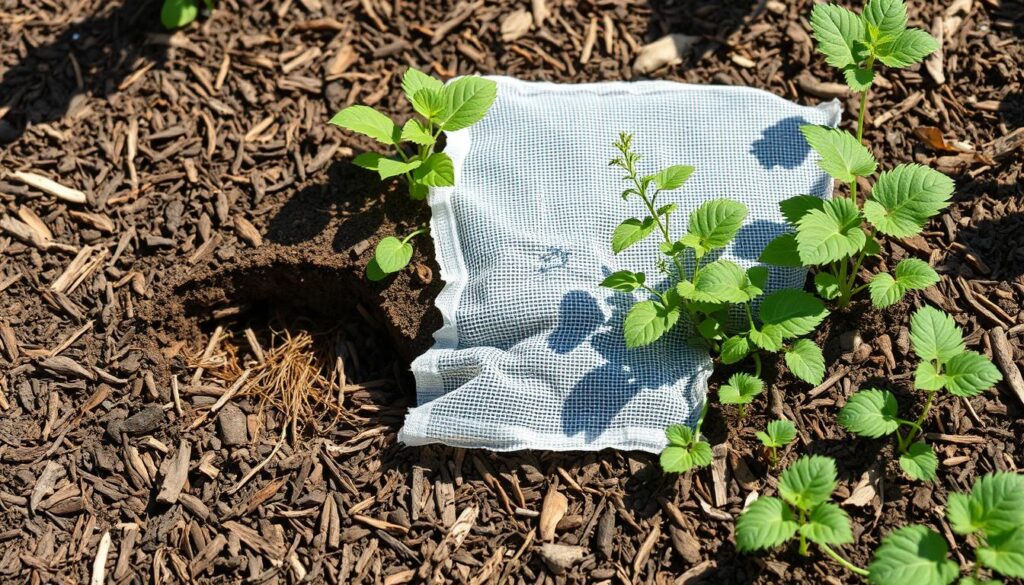
Can Garden Lizards Swim?
Many people wonder if garden lizards can swim. Some lizard species have amazing lizard swimming abilities. For example, the common garden skink (Lampropholis guichenoti) can stay underwater for minutes. This skill helps them avoid predators.
Garden skinks can easily move through shallow water. They use a swimming motion that looks like strokes. Their bodies are shaped to cut through water smoothly.
While some reptiles avoid water, garden skinks like it. They often sit in the sun near water, watching for dangers. This lets them live in different places, making people ask “can garden lizards swim?”
Alternative Solutions to Weed Control
Using only landscaping fabric to control weeds often doesn’t work well. Exploring other options can make weed control more sustainable. One good way is to use mulch to block weeds. A thick layer of mulch, 2 to 4 inches deep, stops weed seeds from growing by covering them.
Maintaining a Healthy Mulch Layer
Keeping your garden healthy means controlling weeds. To keep mulch working well, add more and air it out regularly. Here are some tips I suggest:
- Choose the Right Type of Mulch: Organic mulches, like wood chips or straw, help improve soil as they break down.
- Combine Mulch with Hand Weeding: This method helps get rid of weeds one by one and reduces competition for nutrients.
- Utilize Organic Herbicides: These products can be used along with healthy gardening practices to control hard-to-remove weeds.
By focusing on keeping mulch healthy and using these strategies, I effectively manage weeds naturally. For more specific solutions, liquid herbicides and pond management are great options to consider along with mulch.
Proper Techniques for Mulch Application
Applying mulch the right way is key to a healthy garden. First, I remove weeds and debris from the area. This step makes sure the mulch goes on smoothly.
Then, I spread the mulch evenly over the garden bed. Keeping it 2 to 4 inches thick is crucial, depending on the plants. This thickness helps keep moisture in and stops weeds from growing.
Checking on the mulch often is a good idea. Replacing it every year keeps it working well. This is a key part of my gardening routine.
I also watch how fast the mulch breaks down. If it breaks down too fast, it can take nutrients from the soil. Using mulch that breaks down slowly is best for my garden.
By following these steps, I make sure my plants get what they need. This leads to a garden that’s full of life and color.
Conclusion
In this article, I’ve shared key landscaping tips on the role of mulch in a healthy garden. Mulch and landscaping fabric play different roles in your garden’s health. It’s important to know that using landscaping fabric under mulch can harm soil health and longevity.
Instead of using landscaping fabric, I suggest looking into other ways to control weeds. A thick layer of mulch helps keep weeds away, retains moisture, and feeds the soil. With the right gardening advice, you can make your garden look great for many years.
By taking a full approach to gardening, you can make your garden beautiful and eco-friendly. Using mulch and finding other ways to manage weeds helps create a sustainable garden. This way, your garden will flourish and protect the environment.
FAQ
Can I use landscaping fabric beneath mulch for weed control?
Landscaping fabric can help control weeds, but it’s not always the best choice. Over time, it can get clogged with soil. This blocks water and air from reaching plants. Mulch alone can often stop weeds without the need for fabric underneath.
What are the different types of landscaping fabrics available?
There are many types of landscaping fabrics, like woven and nonwoven ones made from plastic fibers. They all work to stop weeds from growing and block sunlight from reaching the soil. This prevents seeds from germinating.
What essential roles does mulch serve in landscaping?
Mulch is crucial in landscaping for several reasons. It stops weeds from growing, keeps soil moist, controls soil temperature, and boosts soil health. As it breaks down, it adds organic matter and nutrients to the soil.
What ecological benefits does mulch provide?
Organic mulch makes gardens feel more like forests. It turns into humus, helping beneficial microorganisms and improving soil quality. It also helps with water retention and provides a home for wildlife.
What issues may arise from using landscaping fabric beneath mulch?
Landscaping fabric can help with weeds, but it’s not perfect. Seeds from nearby can still sprout in the mulch. The fabric can get clogged, making weeding hard. It can also harm soil health and make changing garden layouts tough.
Can garden lizards swim?
Yes, some lizards can swim. They have special features that let them move through water. They use different swimming strokes and behaviors to cross over shallow water.
What alternative methods can be employed for weed control?
Instead of fabric, a thick layer of mulch (2-4 inches) can stop weed seeds from germinating. Adding mulch with hand weeding and organic herbicides can also help control weeds.
What are the best practices for applying mulch?
To apply mulch right, start by removing weeds. Spread it evenly, depending on the plants you have. Check on it often for signs of decomposition. Replenishing it every year keeps its benefits going.

